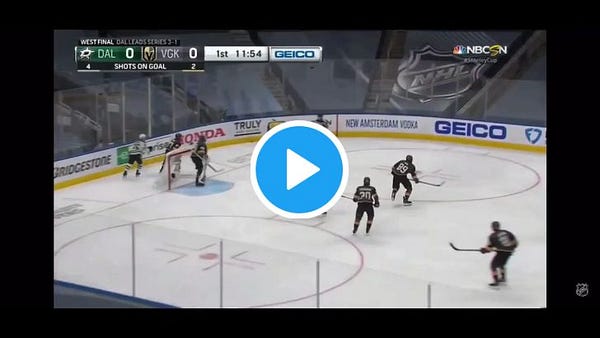The Benefits Of Playing On The Off-Wing
And why coaches at all levels should empower their players to do so
Dan here, checking in today to talk about the benefits of playing on the ‘off-wing’.
One of my frustrations with our game is the overwhelming reluctance to changing the status quo.
What is an off wing? Right handed player on the left side or left handed player on the right side (in the defensive zone)
Often, right-handed wingers are cast as a right-winger because… they always have been. It’s the default setting, and it starts out in youth hockey. But is there actual evidence to support this widely-accepted practice? Or is it just a combination of inaction and apathy that perpetuates the norm? Now more than ever, it’s time we challenge these standards. For coaches, that means creating an environment where players feel empowered.
Playing on the off-wing/off-hand/weak-side has always been of interest to me. In the offensive zone, players can create advantageous shooting angles by cutting to the middle of the ice while staying on their forehand. For righties entering the offensive zone on the right side of the ice, that advantage is inherently negated. On the other hand, in the defensive zone, these strong-side players (are perceived to) have an easier play catching a breakout pass on their forehand.
For defensemen, playing on the strong side is - historically - almost a given. Mike Babcock famously defended Team Canada’s defensive team build (3 left-handed LD, 3-right-handed RD) in 2016. Babcock hated the idea of defensemen playing on their off-hand, arguing it put them in an undesirable spot on their backhand. In his estimation, whatever potential offense that could be created from a shot in the middle of the ice was negated by the defensive liability.
Proprietary Research
In February, a good friend of mine/fellow coach Brandon Nazek and I presented at CBJHAC on the benefits of playing on the off-wing. We were given SportLoqiq player tracking data for the 2018-19 AHL season and analyzed if wingers playing on their off-wing a) generated better scoring chances for and b) had a harder time getting out of their zone than their strong-side counterparts. We thought, genuinely, that we’d see that coaches were justified in playing their players on the strong-side due to weaker defensive zone exits, even if it meant giving up some offense.
However, our findings (briefly) were that, offensively, the shots generated when a player enters the zone on their off-wing are of higher quality in terms of expected goals compared to entry on their strong-side and that, defensively, handedness does not appear to be a factor in terms of controlled exit percentage on either side of the ice (Note: If you want to read more, here is our summary and slide deck).
Simply:
There is no evidence to suggest that wingers see worse results on their off-wing in the defensive zone than strong-side wingers
Wingers will see improved shot quality, expected goals, and actual goal percentages by playing on their off-wing
Our shooting percentage findings are in line with prior work done by New Jersey Devils Director of Analytics Matt Cane and Colorado Avalanche analyst Arik Parnass. Jack Han’s newsletter from May also touched on the same subject:
When looking at over a decade’s worth of NHL shooting data, current Devils analyst Matt Cane found that players shot 9.9% when their sticks were in the middle of the ice vs. 8.6% on their strong sides, a non-trivial difference. Arik Parnass of the Avs also came to the same findings in his public powerplay research.
Added Benefits
So if there’s a consensus that there’s increased shooting percentages, why isn’t it the norm that players play on their off-wing (Our findings showed that 89% of AHL wingers in 2018-19 played on their strong-side)? It must be the perceived defensive weakness. Ironically, there may be some benefits that come from playing on the off-wing in the defensive zone.


Even if you’re not a believer in your off-side wingers in the defensive zone, at an absolute minimum, coaches should utilize players on their off-wing while on the power play. From Parnass:
On the power play, besides simply shooting at a better angle, playing one’s off-wing allows players to one-time pucks towards the net, which is a huge advantage considering the importance of pre-shot movement and forcing the goalie to shift laterally prior to a chance. On the flip side, the inherent disadvantages to playing one’s off-wing all but disappear when up a man. Defense is a secondary consideration on the power play, the puck should be on the boards as little as possible, and with five players against four, there is more space to stickhandle and step into a shot without the danger of a turnover.
Any defensive weakness in the defensive zone is likely attributed to years (decades?) of playing on their strong-side. If youth coaches today empower their players to play multiple positions, they’ll give their players the tools necessary to be comfortable in catching passes on their backhand in the defensive zone.
Changing the norms
When I first started coaching youth hockey, I can remember penciling my lineup and making adjustments based on player’s handedness. Today, I look back and laugh at myself. Encourage your players to play on their off-wing, even if it means some defensive zone struggles along the way.
Ultimately, if we’re not developing kids to problem-solve future obstacles, what are we doing?
Further Reading - Rethinking about what should happen when a goalie drops their stick
Did You Enjoy This Newsletter?
Help us spread the ideas within and share it with the people you care about




